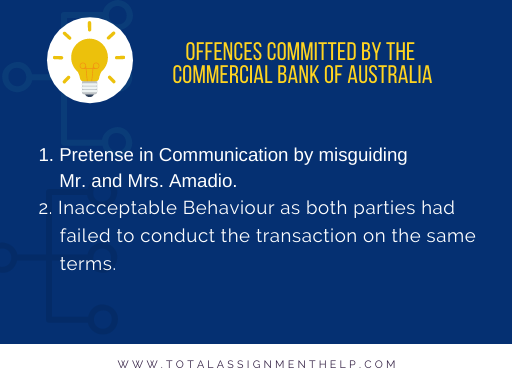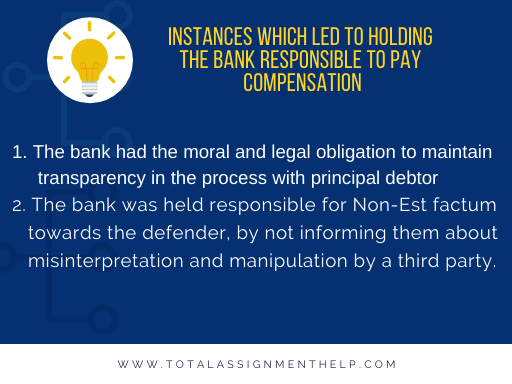Case Study of Commercial Bank of Australia Ltd V Amadio
Question
Task: Provide an elaborate analysis of the case of Commercial Bank of Australia Ltd V Amadio.
Answer
Introduction
While conducting the mortgage on Amadio, the bank was conscious regarding the insecure pecuniary condition of Amadio’s son and also cognizant about the fact that his parents i.e. the Mr. and Mrs. Amadio has no information about his condition. The bank should have the responsibility to inform Amadio that the bank’s responsibility was not only restrained merely as a sponsor which they failed to do (ACL, n.d.). Because of the following reasons, the court of appeal put in service the findings made by the trial judge in the case of Commercial Bank of Australia Ltd V Amadio.
In this case, the judicial bench had put forward the opinion that the bank had the responsibility to make it clear the original situation of the financial statements of the organization, though the bank was abortive in this task and led the party to be predisposed with Vincenzo’s misrepresentation. It was being observed by the court that the bank had only the knowledge possessed by Mr. Virgo. Since Mr. and Mrs. Amadio was not provided with the related facts and hence it was followed that the bank was responsible for the unacceptable behavior conducted by them.
It was further laid by the judiciary that this event was immoral in characteristics for the reason that the bank had taken unjustifiable advantage of the prevailed circumstances rather than other parties who have a special disability (Law Teacher, n.d.). One of the members in the jury panel, Justice Gibbs opined some excellent instances in the case of commercial bank of Australia V Amadio where the bank held responsible to make clear the situation of the financial statement, which are: -
- The bank which conducted the process of insolvency on the company Amadio had the liability to make it clear the transparency of the contract between the borrower and the loan providing bank in the circumstances that this transaction was not normally predictable. One of the judges in the judiciary bench, justice Gibbs, referred to the opinion of pollock MR given in the ruling of the case Lloyds Bank Ltd V Harrison.
- The concerned bank had also the responsibility to portray limpidity in the presence of hidden and unusual factors present in the current issue which had a strong relationship with the account of the affected party.
Two instances in the case which were described by Justice Gibbs, the pivotal point to presume the bank responsible for disclosure:
- The loan taking party i.e. Mr. and Mrs. Amadio, as described in the case study, was to be informed about the present condition of the exceeding limit of overdraft and the sum of the dishonored cheques.
- The similar instance where the bank had the responsibility for disclosure was when the agreement was created by Vincenzo Amadio as the representative of the mentioned bank. The agreement envisaged that an instantaneous limit of overdraft which was $270000 would be provided to the company by laying out the stipulation that this limit could be curtailed to the level of $ 220000 in period of one week by the organization and auxiliary curtailment should be carried out to the level of $180000 within a fortnight. From the above-provided section of the agreement, it could be deduced that it was demanded to curtail the limit of overdraft below the level of debit balance in the present scenario within 3 weeks.
As per the instances provided above, Justice Gibbs had observed two offenses in this Case:-

- Pretense in Communication: The couple were misguided by the agreement and the facts provided which made them sign the contract. An express misinterpretation has happened in this case. But it should be contemplated the misinterpretations were not conducted by any official or the staff of the bank, instead that was performed by Vincenzo Amadio. Justice Gibbs had referred to the Gutch V Homan case [1853] Engr 883; (1853) 4 HLC 997, at pp 1034-1035(10 ER 752, at p 767) while evaluating this particular section of the case.
- Inacceptable behavior: While considering this factor the judiciary bench opined that there was no indication of any conscienceless arrangement, although it could be deduced that both the indulged parties included the beneficiary and had failed to conduct the transaction on the same terms.
Supporting the judgment made by Justice Dean J in the case Justice mason reiterated that the petitioners had all the right to pursue respite from the defendant since the respondent i.e. the bank, was found culpable and responsible for the unacceptable behavior concerning the implementation of the actions conducted by them. The court had guaranteed the defender that in case any party conducts an unacceptable behavior towards an acquitted person whose will was oppressed and hence made the transaction very constrained and dependent. The will was issued to the acquitted party to exploit their financial condition. Hence, the concerned bank, in this case, is also responsible for the bad conduct, which will provide Mr. and Mrs. Amadio with compensation and relief considering this facet.
In this case Justice Mason further went on by revealing various factors which brought into light the heavy manipulation of the bargaining power in between the two engaged parties i.e. the loan providing bank and the debtor in a way where the petitioner was kept at a situation of disadvantage and misappropriation if the mortgage is conducted in accordance with the terms laid by the bank in the contract. By further evaluation it could be observed that the defendant had shown no effort in understanding the context transaction, the bank had failed to put forward in the document. It was further revealed that the defenders had to face with special disadvantage, which was their reliance and trust on the son who failed to accomplish the requirements laid down in the agreement for his interest.
Definition provided by Justice Mason and Justice Dean on Difference between Unconscionable conduct and Undue Influence
In the case of commercial bank of Australia v Amadio, Justice Deane had put forward the argument that the relevant and reasonable principles related to the unconscionable act and the unwarranted influence were directly connected and had displayed very strong relations though these principles were poles apart in their ideology. The unwarranted or undue behavior is regarded as the practice in which the weaker party is expected to be waiting for the approval of a superior party. Though the term unconscionable conduct refers to the condition when the stronger party commences an act to obtain and reserve all the benefits while pursuing the task in the contract and inflict possible risks to the weak party, where the task comprises of dealing with good morals and equity. There are many kinds of principles and ideologies about providing compensation to the special disadvantages caused by the indulged party in unfavorable conditions.
Another member in the judiciary bench, Justice Mason elucidates the dissimilarity between the principles of Undue Influence and the Unconscionable conduct by expressing that the circumstance of the party who implemented the undue influence was not a voluntary or deliberate act since it was coerced. While the instance of unconscionable conduct by the party was because of the unfavorable condition, although it was an independent and deliberate act. In this case of Commercial bank of Australia v Amadio, one of the parties had used their position to obtain unconscientious advantage (High Court of Australia, n.d.).
In the Commercial bank of Australia v Amadio, Mr. and Mrs. Amadio was deemed as the weaker party in the agreement signed between the bank and the defendant. It was because of the special disability of Mr. and Mrs. Amadio in doing business with the bank that they were considered as the weak parties. On this ground, the court had allowed compensation and relief against the unconscionable conduct. The bench had also considered many factors while making the jurisdiction like the limitation of the couples in the knowledge of English language, their age, family condition, and the crooked canvassing and marketing strategies of the bank utilized to get the signature. The major and deciding aspect, in this case, was the ignorance of the couples towards the context and the document. The couples had not received any sort of help or aid from any service which is very important before entering into a contract or equity with another party.
Below are given the instances which provided the basis for laying the bank responsible to pay compensation to the defender: -

- The bank mentioned in this case had the moral and legal obligation to maintain transparency in the processes being executed with the principal debtor and from the guarantor point of view, this sort of transaction was not being anticipated.
- The bank was also held responsible towards the defender in the case of Non-Est factum for the defender, which implies that the bank was persuaded to deliver assurance on the base that the misrepresentation and the manipulation are being conducted towards the customer utilizing a third party.
References
ACL. Commercial Bank of Australia v Amadio, (1983) 151 CLR 447; [1983] HCA 14. civil-engineering at: https://www.australiancontractlaw.com/cases/amadio.html. Accessed on 23rd January 2018.
Commercial Bank of Australia Ltd v Amadio [1983] HCA 14; (1983) 151 CLR 447 (12 May 1983).
Gutch v Homan [1853] EngR 883; (1853) 4 HLC 997, at pp 1034-1035(10 ER 752, at p 767).
High Court of Australia. Commercial Bank of Australia Ltd v Amadio [1983] HCA 14; (1983) 151 CLR 447 (12 May 1983). Available at: https://www8.austlii.edu.au/cgi-bin/viewdoc/au/cases/cth/HCA/1983/14.html. Accessed on 23rd January 2018.
Law Teacher. Commercial Bank Of Australia V Amadio. Available at: https://www.lawteacher.net/free-law-essays/contract-law/commercial-bank-of-australia-v-amadio-contract-law-essay.php. Accessed on 23rd January 2018.
Pollock MR in Lloyds Bank Ltd v Harrison (1925).
Wiley. Commercial Bank of Australia Ltd v Amadio and another. Available at: https://www.johnwiley.com.au/highered/blaw/content110/case_summaries/bank_of_australia_vs_amadio.pdf. Accessed on 23rd January 2018.












